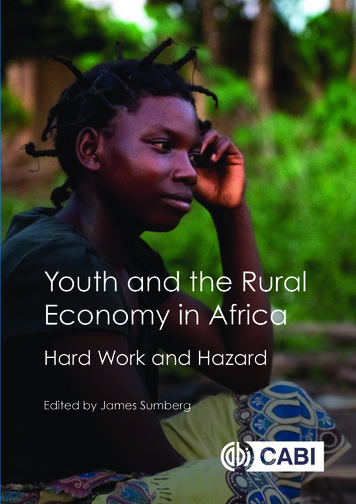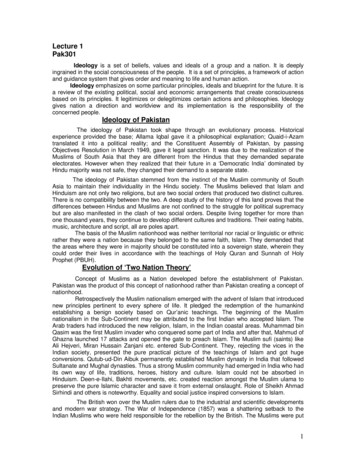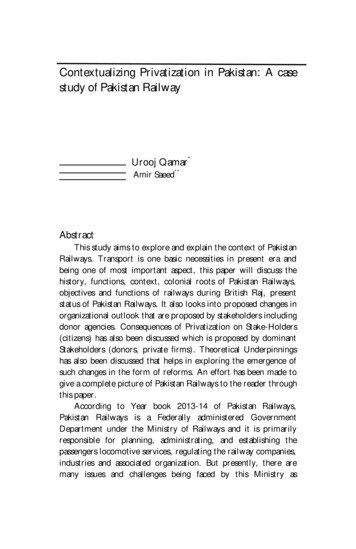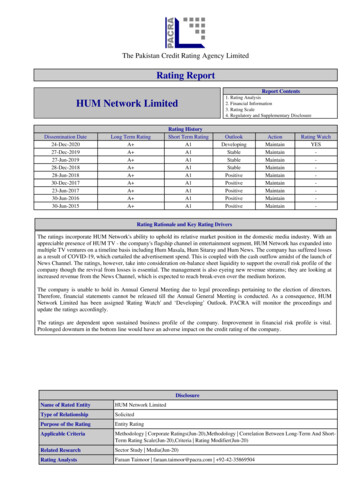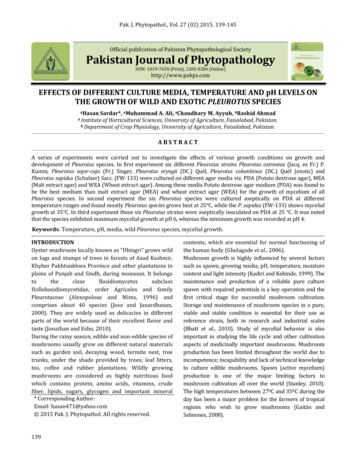
Transcription
Pak. J. Phytopathol., Vol. 27 (02) 2015. 139-145Official publication of Pakistan Phytopathological SocietyPakistan Journal of PhytopathologyISSN: 1019-763X (Print), 2305-0284 (Online)http://www.pakps.comEFFECTS OF DIFFERENT CULTURE MEDIA, TEMPERATURE AND pH LEVELS ONTHE GROWTH OF WILD AND EXOTIC PLEUROTUS SPECIESaHasanSardar*, aMuhammad A. Ali, aChaudhary M. Ayyub, bRashid Ahmadof Horticultural Sciences, University of Agriculture, Faisalabad, Pakistan.b Department of Crop Physiology, University of Agriculture, Faisalabad, Pakistan.a InstituteABSTRACTA series of experiments were carried out to investigate the effects of various growth conditions on growth anddevelopment of Pleurotus species. In first experiment six different Pleurotus strains Pleurotus ostreatus (Jacq. ex Fr.) P.Kumm, Pleurotus sajor-caju (Fr.) Singer, Pleurotus eryngii (DC.) Quél, Pleurotus columbinus (DC.) Quél (exotic) andPleurotus sapidus (Schulzer) Sacc. (FW-133) were cultured on different agar media viz. PDA (Potato dextrose agar), MEA(Malt extract agar) and WEA (Wheat extract agar). Among these media Potato dextrose agar medium (PDA) was found tobe the best medium than malt extract agar (MEA) and wheat extract agar (WEA) for the growth of mycelium of allPleurotus species. In second experiment the six Pleurotus species were cultured aseptically on PDA at differenttemperature ranges and found mostly Pleurotus species grows best at 25 C, while the P. sapidus (FW-133) shows mycelialgrowth at 35 C. In third experiment these six Pleurotus strains were aseptically inoculated on PDA at 25 C. It was notedthat the species exhibited maximum mycelial growth at pH 6, whereas the minimum growth was recorded at pH 4.Keywords: Temperature, pH, media, wild Pleurotus species, mycelial growth.INTRODUCTIONOyster mushroom locally known as “Dhingri” grows wildon logs and stumps of trees in forests of Azad Kashmir,Khyber Pakhtunkhwa Province and other plantations inplains of Punjab and Sindh, during monsoon. It omycetidae, order Agricales and familyPleurotaceae (Alexopolous and Mims, 1996) andcomprises about 40 species (Jose and Janardhanan,2000). They are widely used as delicacies in differentparts of the world because of their excellent flavor andtaste (Jonathan and Esho, 2010).During the rainy season, edible and non-edible species ofmushrooms usually grow on different natural materialssuch as garden soil, decaying wood, termite nest, treetrunks, under the shade provided by trees; leaf litters,tea, coffee and rubber plantations. Wildly growingmushrooms are considered as highly nutritious foodwhich contains protein, amino acids, vitamins, crudefiber, lipids, sugars, glycogen and important mineral* Corresponding Author:Email: hasan471@yahoo.com 2015 Pak. J. Phytopathol. All rights reserved.139contents, which are essential for normal functioning ofthe human body (Gbolagade et al., 2006).Mushroom growth is highly influenced by several factorssuch as spawn, growing media, pH, temperature, moisturecontent and light intensity (Kadiri and Kehinde, 1999). Themaintenance and production of a reliable pure culturespawn with required potentials is a key operation and thefirst critical stage for successful mushroom cultivation.Storage and maintenance of mushroom species in a pure,viable and stable condition is essential for their use asreference strain, both in research and industrial scales(Bhatt et al., 2010). Study of mycelial behavior is alsoimportant in studying the life cycle and other cultivationaspects of medicinally important mushrooms. Mushroomproduction has been limited throughout the world due toincompetence; incapability and lack of technical knowledgeto culture edible mushrooms. Spawn (active mycelium)production is one of the major limiting factors tomushroom cultivation all over the world (Stanley, 2010).The high temperatures between 27ºC and 35ºC during theday has been a major problem for the farmers of tropicalregions who wish to grow mushrooms (Gaitán andSalmones, 2008).
Pak. J. Phytopathol., Vol. 27 (02) 2015. 139-145Therefore, the selection for tolerance to hightemperatures in the cultivable mushroom species isessential to obtain optimum yield and quality (Milesand Chang, 1997). The identification of suitable agarmedia, substrate and incubation temperature isessential to obtain high yield and quality ofmushroom. Previous studies reported the effects ofdifferent agar media and substrates on growth andquality of mushroom mycelium but most of theseinvolved the use of only few media. Therefore, thepresent study aimed at investigating the behavior ofvarious oyster mushroom strains under differentmedia, temperature, and pH requirements formycelial growth.MATERIALS AND METHODSExperimental layout: Three experiments wereconducted. The first experiment was performed toevaluate the effect of different media on the mycelialgrowth of wild and exotic Pleurotus spp.; the second andthird experiments were performed to determine theeffects of temperature and pH respectively on agar media.All the experiments were carried out in the growth roomof Medicinal and Mushroom Laboratory, Institute ofHorticultural Sciences, University of Agriculture,Faisalabad. The experiments were laid out in a completelyrandomized design with three replications in eachtreatment. Each experiment was repeated three times andthe data presented are the mean of values obtained fromthese experiments.Strains collection: Mushroom species werecollected from different localities of Punjab provincesuch as University of Agriculture, Faisalabad,Guttwala Forest area Faisalabad, Changa MangaForest area Lahore. From these collected speciesPleurotus spp. were identified on morphologicalcharacteristics in Mushroom Lab (Institute ofHorticulturalSciences)andMycologyLab(Department of Plant Pathology), University ofAgriculture, Faisalabad. Species of Pleurotus genusused for the study are shown in Table 1.Table 1. Source of different wild and exotic Pleurotus species.Mushroom SpeciesSourcePleurotus sapidus (FW-133)Wild Pakistani strainPleurotus ostreatusUSAPleurotus sajor-cajuCanadaPleurotus columbinusUKPleurotus eryngiiUSAFW Faisalabad wild140Experiment No. 1. Effect of different culture mediaon growth of Pleurotus species.Culture Preparation:Following culture media were used for the mycelialgrowth of Pleurotus species. Potato dextrose agar (PDA): PDA medium wasprepared by adding 20 g each of potato starch,dextrose, agar and 1 L distilled water andautoclaved it at 121 C for 15 minute. Malt extract Agar (MEA): MEA medium wasprepare by adding 20 g each of malt extract,dextrose, agar and 1L distilled water andautoclaved as described earlier. Wheat extract agar (WEA): WEA medium wasprepared by adding extract of 200g wheatgrains, 20 g dextrose, 20 g agar and 1 L distilledwater and autoclaved as described earlier.The medium were then poured in clean 90 mm Petridishes. Streptomycin was added in the sterilizedmedium at the rate of 1 g/L. Medium were cooled at40 C; the strains were inoculated in above mentionedmedia and incubated for ten days to prepare solidifiedplates of PDA, MEA and WEA under sterile conditions at25. The radial growth was measured following themethod reported by Zharare et al. (2010).Isolations from the fresh specimens, collected from thewild collection of Pleurotus spp. were made by followingthe standard tissue culture technique. Fresh samples ofPleurotus spp. were cut across the pileal region with thehelp of a sterilized sharp blade to get 2-3 mm bits. Thesebits were dipped in 0.1% mercuric chloride solution,with the help of sterilized forceps, for 5-10 seconds andwere washed five times using sterilized distilled waterand later placed on sterilized filter paper to removeexcess moisture. The four measurements were thanaveraged to obtain mean radial growth per petri dish.Pleurotus strains were inoculated in petri platescontaining sterilized media i.e. PDA, MEA, WEA in alaminar flow hood. A small block (ca. 5mm2) ofmycelium from an actively growing pure culture wasplaced at the center of the media at the point where theradial lines intercepted.Experiment No. 2. Effect of different temperaturelevels on the growth of Pleurotus species.After standardization of agar media in experiment 1 forthe mycelial growth of Pleurotus species temperaturewas optimized. Pleurotus strains (wild and exotic) were
Pak. J. Phytopathol., Vol. 27 (02) 2015. 139-1452.2-fold higher as compared to P. eryngii (Figure 2).Similarly, the interactive effect of species and agar mediaalso showed that the P. sapidus (FW-133) exhibited thehighest mycelium growth on PDA media (Figure 3).Mycelial growth (cm/day)0.70.60.50.40.30.20.10PDAMEAGrowing mediaWEAFigure 1. The comparison among agar media for themycelial growth of Pleurotus spp. Vertical bars represent S.E of means (n 15).Mycelial growth (cm/day)inoculated separately in the Petri dishes of PDA mediaand incubated at 15 C, 20 C, 25 C, 30 C and 35 C in 3replicates and mycelial growth was recorded in cm/day.Experiment No. 3. Effect of different pH levels on thegrowth of Pleurotus species.After optimization of temperature, these species wereoptimized for their pH requirement. Therefore, differentlevels of pH (4, 5, 6, 7 and 8) of the PDA media weremaintained by adding 1 M solutions of HCl and NaOH.Inoculations were made by the same way as in the firstexperiment in three replicates and the plates wereincubated at 25 C. Mycelial growth was also measuredthe same way as in temperature experiment.Statistical analyses: The data collected from threeexperiments for each study, was analyzed statistically usingthe MSTAT-C (Russel and Eisensmith, 1983). Fisher’sanalysis of variance technique was used to test the overallsignificance of the data, while the Least SignificantDifference (LSD) test (P 0.05) was used to compare thedifferences among treatment means (Steel et al., 1997).RESULTSExperiment 1: Pleurotus spp. showed significant (P 0.05) differences regarding mycelial growth on differentgrowing agar media i.e. PDA, MEA and WEA. Amongthese growing agar media, on an average PDA showedfastest (0.52 cm/day) mycelial growth of Pleurotus spp.(Figure 1) followed by MEA (0.47 cm/day) while,slowest mycelial growth of all Pleurotus spp. (0.41cm/day) were observed on WEA. As far as differentPleurotus spp. are concerned, P. sapidus (FW-133)showed the highest mycelial growth which was about0.80.60.40.20Pleurotus Pleurotus Pleurotus Pleurotus Pleurotusostreatus sajor caju sapidus columbinus eryngiiwildPleurotus spp.Figure 2. The mycelial growth recorded in variousPleurotus spp. on different agar media. Vertical barsrepresent S.E of means (n 9).Mycelial growth (cm/day)10.8PDAMEAWEA0.60.40.20Pleurotus ostreatusPleurotus sajor cajuPleurotus sapidusPleurotus columbinusPleurotus eryngiiPleurotus spp.Figure 3. The interactive effect between different growing agar media and Pleurotus spp. Vertical bars represents S.Eof means (n 3).Experiment 2: Among different temperature levelsgrowth (Figure 4). All the Pleurotus spp. showed theirPleurotus spp. showed significant variation of mycelialhighest mycelium growth at 25 C (Figure 5). The fastest141
Pak. J. Phytopathol., Vol. 27 (02) 2015. 139-145mycelial radial growth (0.90 cm/day) was exhibited by P.sapidus (FW-133) followed by P. sajor-caju (0.80 cm/day), P.ostreatus (0.79 cm), P. columbinus (0.64 cm/day) while theslowest mycelial growth was observed in P. eryngii whichwas about 0.43 cm on day-1 at 25 C in dark (Figure 6).However, at 35 C mycelium growth was stopped in allthe Pleurotus spp. except P. sapidus (FW-133) with 0.63cm/day mycelial growth.0.80.60.40.20Pleurotus Pleurotus Pleurotus Pleurotus Pleurotusostreatus sajor caju sapidus columbinus eryngiiwildMycelial grwoth (cm/day)Myceil growth (cm/day)0.80.60.40.2035oCPleurotus spp.Myceil growth (cm/day)Pleurotus ostreatus25oC20oC15 oCTemperature levelsFigure 4. The mycelial growth of Pleurotus species ondifferent temperatures levels. Vertical bars represents S.E of means (n 15).130oCPleurotus sajor-cajuFigure 5. The effect of different temperature levels onmycelial growth of Pleurotus species. vertical barsrepresent S.E of means (n 15).Pleurotus sapidusPleurotus columbinusPleurotus eryngii0.80.60.40.2015 C 20 C 30 C25 C35 CGrwoing temperatureFigure 6. The interactive effect of Pleurotus species and different temperature levels for the mycelial growth. verticalbars represent S.E of means (n 3).142Mycelial growth (cm/day)1Experiment 3: Influence of pH media on the growthof mushroom was studied in the absence of light at25 C. The pH levels of PDA were significantlyaffected the mycelium growth of oyster mushroom.Maximum growth of Pleurotus spp. was observed atpH 6 while minimum mycelial growth was observedat pH 4 (Figure 7). Among the Pleurotus spp., P.sapidus (FW-133) exhibited highest growth (0.923cm/day) followed by P. sajor-caju (0.85cm/day), P.ostreatus (0.81cm/day), P. columbinus (0.68 cm/day)and P. eryngii (King oyster mushroom) (0.433cm/day) at different pH levels (Figure 8).0.80.60.40.245678pH LevelsFigure 7. The mycelial growth of Pleurotus species atdifferent pH levels. vertical bars represent S.E ofmeans (n 15).
Pak. J. Phytopathol., Vol. 27 (02) 2015. 139-1451.4Mycelial growth (cm/day)1.2Pleurotus ostreatusPleurotus sajor cajuPleurotus sapidusPleurotus columbinusPleurotus eryngii10.80.60.40.20456pH levels78Figure 8. The interactive effect of Pleurotus species and pH levels for mycelial growth. Vertical bars represent S.E ofmeans (n 3)DISCUSSION(Suharban and Nair, 1994), who reported that mycelia ofMicroorganisms need nutrients, a source of energy andthe Pleurotus spp. grow faster on slightly acidic mediumcertain environmental conditions in order to grow andthan basic media. Oyster mushroom (Pleurotus spp.)reproduce (Ravimannan et al., 2014). Among differentstudied in this study decreased its mycelial growth at pHgrowing agar media used in this investigation i.e. PDA,4 and 5 levels. Overall, decrease in growth may be due toMEA, and WEA, Potato dextrose agar proved to be thereduced hyphal growth that subsequently had affectedbest media for the mycelial growth of Pleurotus species.its enzymatic activity of respective mycelia. LikewiseThis difference of mycelial growth on different agarobservation has also been reported previously bymedia may be due to availability of different carbonZadrazil (1978) that P. ostreatus and P. eryngii showedsources and other required nutrients. Mycelium growthsignificant decrease in mycelial growth at pH 4.0 whichwas marginally better on a medium containing glucoseis too acidic. However, Some Pleurotus spp. areand sucrose than other sources (Santiago, 1983).characterized for wider growth adaptability scale for pHMoreover, PDA might exhibit higher carbon sources andi.e. 5-8 as reported by Yadav (2001). The mycelialnutrients for mushroom mycelia in petri plate. Ourgrowth of P. ostreatus was recorded best at pH 7.0 byresults are in agreement with the findings of Gibriell etBugarski et al. (2000). It is evident from the results thatal. (1996); Hussain and Hussain, (2004) who reportedP. sapidus (FW-133) can perform best in term of itsthat Pleurotus spp. showed fastest growth of myceliummycelial growth around pH (6-7) in sub-tropical regionon potato dextrose agar among different media used.(Punjab) Pakistan.In general, temperature and pH are the most importantTemperature is an important aspect in the selection ofenvironmental factors that control the growth ofmushroom for the tropics where high temperaturemicroorganisms. pH and temperature effects the growthremains for most of the time. Mushroom test (Pleurotus)of Pleurotus spp. through affecting the enzyme activity inspecies are usually attributed for higher growth rate atthe cell (Sopit, 2006). For mycelial growth, pH is another25ºC. Previously, optimum temperature within thisimportant factor that affects the growth potential ofrange was reported by Zharare et al. (2010) byfungus. In this study, it was observed that most ofobserving maximum growth of Pleurotus strains. Thus, itPleurotus spp. showed superior growth at pH 6. Amongappears that 20-25ºC was universal temperature rangethese test species, P. sapidus (FW-133) showedfor the mycelial growth of mushrooms. In addition,maximum growth adaptability scale at pH (6-7). It mightfungus also exhibited maximum enzymatic activitybe attributed to genetic differences found in differentwithin this range and growth inhibition at elevatedspecies of genus Pleurotus. As, Karacanci (1997) noticedtemperature (Kausar, 1988). However, P. sapidus (FWmaximum mycelial growth in P. ostreatus at pH 6.5133), collected from the sub-tropical region hasThese results are in accordance to the findings oftendency to survive and continue its enzymatic activity143
Pak. J. Phytopathol., Vol. 27 (02) 2015. 139-145even at 35ºC. Temperature sensitivity index of Pleurotusspp. revealed greater genetic difference among thegenus Pleurotus. Similar results were found by Wei et al.(2002) who reported a temperature range of 20-31ºCfor the hyphal growth of P. flabellatus and concludedthat a temperature of 25ºC is the optimum. Similarly,Zharare et al. (2010) found that P. sajor-caju can toleratehigh 35ºC temperature.CONCLUSIONPleurotus spp. performed best when grown attemperature of 25 C for the fastest mycelial growth.However, P. sapidus (FW-133) can tolerate temperatureof 35 C, which can be grown on sub-tropical hightemperature areas. As for as different growing media areconcerned PDA media proved to be the best media forthe growth of Pleurotus spp. pH level must bemaintained at 6 for best growth of Pleurotus spp.ACKNOWLEDGEMENTThe authors are grateful to Higher EducationCommission (HEC) of Pakistan for financial support tothis study (Av-7-206).REFERENCEAlexopoulos, C. J., C. W. Mims and M. Blackwell. 1996.Introductory Mycology. John Willey and Sons. Inc.,New York, 868.Bhatt, P., R.P. Singh and S.C. Sati. 2010. Evaluation ofdifferent Pleurotus hybrids for their growthrequirements in-vitro. Indian. Phytopath. 63:424-426.Bugarski, D., D. J. Gvozdenovic, J. Cervenski and A. Takac.2000, October. Effect of major environmentalconditions on the development of the myceliumand growth of the oyster mushroom (Pleurotusostreatus). In II Balkan Symposium on Vegetablesand Potatoes 579 (pp. 319-323).Gaitán, H.R. and D. Salmones. 2008. Obtaining andcharacterizing Pleurotus ostreatus strains forcommercialcultivationunderwarmenvironmental conditions. Scientia. Hortic.118:106-110.Gbolagade, J.S., I.O. Fasidi, E.J. Ajayi and A.A. Sobowale.2006. Effect of physico- chemical factors and semisynthetic media on vegetative growth of Lentinussubnudus (Berk.), an edible mushroom fromNigeria. Food. Chem. 99: 742-747.Gibriel, A.Y., M. Ahmed, N. Rasmy, I. Rizk and N.S. AbdelRehem. 1996. Cultivation of oyster mushrooms(Pleurotus spp.): Evaluations of different media144and organic substrates. In: Mushroom biology andMushroom Products Proceedings of the 2ndInternational Conference, Pennsylvania, USA (pp.415-421).Hussain, A. and N. Hussain. 2004. Evaluation of differentmedia, spawn and substrates for the cultivation ofPleurotus ostreatus in Muzaffarabad (Pakistan).Mycopath. 2:67-69.Jonathan, S. G. and E.O. Esho. 2010. Fungi and aflatoxindetection in two oyster mushrooms Pleurotusostreatus and Pleurotus Pulmonarius from Nigeria.Electronic J. Env. Agric. Food. Chem. 9: 1722-1730.Jose, N. and K.K. Janardhanan. 2000. Antioxidant andantitumor activity of Pleurotus florida. Curr. Sci.79: 941-943.Kadiri, M. and I.A. Kehinde. 1999. Production of grainmother and planting spawns of Lentinus subnudus.Niger. J. Bot. 12: 37-44.Karacanci, S. 1997. An investigation on biomassproduction of Pleurotus sajor-caju and Lentinusedodes in submerged culture. Paper presented inIndian mushroom conference – 97 at NCMRTSolan from 10-13th September, 7.Kausar, T. 1988. Cultivation of mushrooms using cropresidues as substrate, Ph.D. Thesis. Dept. Bot.Univ. Pun. Lahore, Pak.Miles, P.G. and S.T. Chang. 1997. Mushroom Biology:Concise Basics and Current Developments. WorldSci. Press, Hong Kong. 105-106.Ravimannan, N., R. Arulanantham, S. Pathmanathan andK. Niranjan. 2014. Alternative culture media forfungal growth using different formulation ofprotein sources. Annals. Biol. Res. 5:36-39.Russell, D. F. 1986. MSTAT-C package programme. Cropand Soil Science Department, Michigan StateUniversity, USA.Santiago, C.M. Jr, 1983 Basidiocarp production inVolvariella volvacea in laboratory cultures. Kalikasan,Philippines Journal of Biology, 12: 70-76.Stanley, O. H and G. Awi-Waadi. 2010. Effect of substrates ofspawn production on Mycelia of Oyster Mushroomspecies. Res. J. Appl. Sci. 5: 161-164.Steel, R.G.D., J.H. Torrie and D.A. Dickey. 1997. Principlesand Procedures of Statistics: A BiometricalApproach. 3rd ed. McGraw Hill Book Co., New York.Suharban, M. and M. C. Nair. 1994. Physiological studieson Pleurotus spp. Mushroom. Res. 3: 87-104.
Pak. J. Phytopathol., Vol. 27 (02) 2015. 139-145Wei, S.H., Y.Y. Jie, H.L. Rong, H.L. Li and M.G. Yan. 2002.Effects of different cultivation conditions onhyphal growth of Pleurotus flabellatus. Ediblefungi of China. 23(2): 29-30.Yadav, B.R. 2001. Physical and Nutritional factors inrelation to growth of Pleurotus sajor-caju (Fr.)Singer. J. Phytol. Res. 14: 95-98.145Zadrazil, F. 1978. Cultivation of Pleurotus. The biologyand cultivation of edible mushrooms by S.T. Changand W.A. Hayes (eds). Academic press INC.Orlando, Florida. 1: 62.Zharare, G.E., S.M. Kabanda and J.Z. Poku. 2010. Effects oftemperature and hydrogen peroxide on mycelialgrowth of eight Pleurotus strains. Scientia. Hortic.125: 95-102.
Study of mycelial behavior is also important in studying the life cycle and other cultivation aspects of medicinally important mushrooms. Mushroom production has been limited throughout the world due to incompetence; incapability and lack of technical knowledge to culture edible mushrooms. Spawn (active mycelium)

